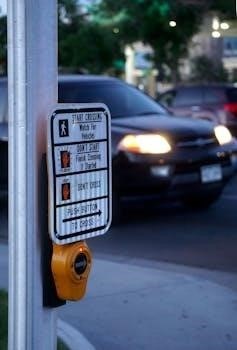
Chapter 6 of the Traffic Signs Manual provides comprehensive guidance on temporary road signs and traffic management for road works. It ensures safety for workers and road users alike, and it is crucial.
The primary purpose of Chapter 6 within the Traffic Signs Manual is to offer detailed instructions and best practices concerning temporary traffic management at road works. This encompasses the correct usage, placement, and maintenance of various road signs, road markings, and traffic control devices. It aims to ensure the safety of both road workers and the general public navigating through or around construction zones. The scope of this chapter covers a wide array of scenarios, from simple lane closures to complex diversions, addressing the specific signage needs for each situation. Furthermore, it provides guidance on adapting signage to different road types, traffic volumes, and environmental conditions. Adherence to Chapter 6 is essential for minimizing disruptions, preventing accidents, and maintaining efficient traffic flow during road maintenance and construction activities. It serves as a vital resource for anyone involved in planning, implementing, or overseeing temporary traffic management schemes.
Purpose and Scope of Chapter 6
Target Audience and Applicability
The target audience for Chapter 6 of the Traffic Signs Manual encompasses a wide range of professionals involved in road works and traffic management. This includes traffic engineers, construction site managers, highway maintenance crews, and local authority personnel responsible for planning and overseeing road projects. Furthermore, it is relevant to contractors, utility companies, and any organization undertaking work that may impact public roadways. The guidance provided is applicable to all types of roads, from minor residential streets to major highways and motorways. Chapter 6 addresses various scenarios, including short-term maintenance activities, long-term construction projects, and emergency road closures. Its principles apply regardless of the size or duration of the road works, ensuring consistent and effective traffic management practices across all situations. Understanding and adhering to the guidelines outlined in Chapter 6 is crucial for ensuring the safety of workers and the public, minimizing traffic disruption, and maintaining efficient traffic flow during road works.

Road Works Signing⁚ General Principles
Effective road works signing prioritizes safety and clarity. Signs should be visible, understandable, and appropriately placed to guide drivers safely through or around the work zone, minimizing confusion.
Basic Requirements for Road Works Signing
Road work signing must adhere to several fundamental requirements to ensure effectiveness and safety. Firstly, signs should be clearly visible, using reflective materials and appropriate sizing for the expected viewing distance. Placement is crucial, ensuring signs are positioned well in advance of the hazard to provide adequate warning and decision time. Signs must be maintained in good condition, clean, and free from obstructions. The information conveyed must be concise, using standard symbols and clear language, avoiding ambiguity.
Furthermore, the sequence of signs should be logical and consistent, guiding drivers through the work zone in a predictable manner. All signs must comply with the regulations outlined in the Traffic Signs Manual, including specifications for design, size, and placement heights. The number of signs used should be sufficient to convey the necessary information without causing information overload, and all signs should be removed or covered when the road works are completed to avoid confusion.
Legal Framework and Compliance
Compliance with the legal framework governing road works signing is paramount to ensure safety and avoid potential liabilities. The Traffic Signs Manual Chapter 6 details the specific regulations and guidelines that must be followed when implementing temporary traffic management schemes. These regulations are derived from national traffic laws and are legally enforceable. Failure to comply with these regulations can result in penalties, including fines and legal action, should an accident occur as a result of inadequate or incorrect signing.
Road authorities and contractors have a legal responsibility to ensure that all road works signing is compliant with the Traffic Signs Manual. This includes ensuring that all signs are of the correct design, size, and reflectivity, and that they are placed in accordance with the specified guidelines. Regular audits and inspections should be conducted to verify compliance and identify any areas for improvement. Furthermore, all personnel involved in the design, installation, and maintenance of road works signing should be adequately trained and competent in the relevant regulations and procedures.
Types of Signs Used in Road Works
Road works utilize various sign types, including warning signs, mandatory signs and information signs. These signs are essential for informing and directing road users safely through the work zone.
Warning Signs⁚ Design and Application
Warning signs in road works are designed to alert drivers to potential hazards ahead. These signs typically feature a triangular shape with a red border and a symbolic representation of the hazard. Common examples include “Road Works Ahead,” “Reduce Speed Now,” and signs indicating lane closures or diversions.
The application of warning signs involves placing them at appropriate distances before the hazard to provide drivers with sufficient time to react. The positioning depends on factors like road speed and visibility. Accurate sign placement is crucial for effective hazard communication. Warning signs play a critical role in preventing accidents and ensuring the safety of both workers and road users. It is important to consider all factors when designing and applying warning signs for road works.
Compliance with regulations in the Traffic Signs Manual is mandatory.
Mandatory Signs⁚ Design and Application
Mandatory signs in road works instruct drivers on specific actions they must take. These signs are typically circular with a blue background and white symbols or text. Common examples include “Keep Left,” “Minimum Speed,” and “No Entry.” They are crucial for regulating traffic flow and ensuring safety within the work zone.
The application of mandatory signs involves placing them at the point where the instruction takes effect. Their positioning must be clear and unambiguous. Factors to consider include visibility, road layout, and the specific requirement being enforced. Effective use of mandatory signs is essential for maintaining order and preventing confusion among drivers.
Compliance with the Traffic Signs Manual is essential for legal adherence and public safety. Proper design ensures clear communication, while proper application guarantees driver compliance, creating a safer environment for everyone involved in road works.

Road Markings and Traffic Control Devices
Effective road markings and traffic control devices are essential for guiding traffic safely through road work zones. These elements enhance visibility, delineate lanes, and protect workers and drivers.
Temporary Road Markings
Temporary road markings play a crucial role in guiding drivers through altered road layouts during construction or maintenance. These markings must be clear, visible, and easily distinguishable from permanent markings to avoid confusion. Materials used should be durable enough to withstand traffic and weather conditions for the duration of the road work but also be easily removable without damaging the existing road surface.
Reflective tapes and paints are commonly employed, ensuring visibility during both day and night. Regular inspections are necessary to maintain their effectiveness, and prompt replacement of worn or damaged sections is vital. The layout of temporary markings should accurately reflect the new traffic flow, matching any temporary signage in place to provide a cohesive and understandable guidance system for all road users. Proper application and maintenance are key to ensuring safety and minimizing disruptions.
Use of Cones, Barriers and Other Devices
Cones, barriers, and other traffic control devices are essential for delineating work zones, guiding traffic flow, and protecting both workers and road users. Cones are primarily used for temporary lane closures and to warn drivers of hazards, while barriers offer more substantial protection, especially in high-speed areas or where significant physical separation is needed.
Different types of barriers exist, including concrete barriers, plastic barriers, and water-filled barriers, each suited for specific applications. The selection and placement of these devices must be carefully considered based on factors like traffic volume, speed limits, and the nature of the road work. Proper spacing, visibility, and stability are crucial for their effectiveness. Regular inspections and maintenance are also necessary to ensure they remain in good condition and continue to provide adequate protection and guidance throughout the duration of the road works. These devices must comply with safety regulations.

Specific Situations and Signage
This section addresses unique scenarios encountered during road works, detailing appropriate signage. These situations include accommodating pedestrians, cyclists, and managing mobile lane closures to maintain safety and efficiency.
Signage for Pedestrians and Cyclists
Ensuring the safety of pedestrians and cyclists during road works requires specific signage and traffic management measures. The Traffic Signs Manual Chapter 6 emphasizes clear and concise information for these vulnerable road users.
Signs must indicate alternative routes, temporary crossings, and potential hazards like uneven surfaces or construction equipment. Consider using tactile paving and audible signals at pedestrian crossings for visually impaired individuals. Cyclists need designated cycle lanes or shared paths, clearly marked with appropriate signage.
Where diversions are necessary, ensure they are well-lit and regularly maintained. Communicate changes in surface conditions that could affect cyclists’ stability. Prioritize pedestrian and cyclist safety during the planning and execution of road works by adhering to Chapter 6 guidelines. This includes regular inspections to ensure signs remain visible and effective, promoting safe passage for all.
Signage for Mobile Lane Closures
Mobile lane closures present unique challenges requiring specific signage strategies. Chapter 6 addresses these challenges to maintain safety and traffic flow during operations like road marking or sweeping.
Utilize advance warning signs indicating a moving works vehicle ahead. These signs must be highly visible and strategically placed to provide adequate reaction time. A designated “shadow vehicle,” equipped with flashing amber lights and a clear “Lane Closed” sign, protects the work area from approaching traffic.
Consider using variable message signs (VMS) to dynamically update drivers about the lane closure’s location and speed. Regularly inspect the signage setup to ensure it remains effective and adaptable to changing traffic conditions. Properly trained personnel should manage the mobile lane closure, ensuring compliance with Chapter 6 guidelines. The goal is to minimize disruption while safeguarding both workers and motorists, requiring proactive management.

Maintenance and Removal of Signs
Proper maintenance and timely removal of temporary road work signs are crucial. This ensures continued effectiveness and prevents confusion after the work is completed, maintaining road safety.
Inspection and Replacement of Signs
Regular inspection of road work signs is essential to guarantee visibility and legibility. Signs should be checked for damage, fading, or obstruction, ensuring they meet required standards. Damaged or inadequate signs must be promptly replaced. This includes addressing issues like vandalism or weather-related wear and tear.
The frequency of inspections should be determined by factors such as traffic volume, environmental conditions, and the type of sign. A proactive approach to maintenance minimizes risks and keeps road users well-informed. Accurate record-keeping of inspections and replacements is crucial for accountability and future planning. Proper sign maintenance is a critical element in ensuring the safety of both workers and the public during road works, adhering to guidelines and specifications outlined in the Traffic Signs Manual. This contributes to smoother traffic flow and reduces potential accidents.
Procedures for Removing Temporary Signs
Removing temporary road work signs promptly after the completion of the works is crucial. A systematic procedure should be in place to ensure no sign is left behind. The removal process should begin with a thorough site inspection to verify all temporary signs are identified and accounted for.
Signs must be removed carefully to avoid damage to the surrounding environment. Posts should be extracted properly, and any holes filled. Removed signs should be stored appropriately for reuse or disposed of responsibly according to environmental regulations. A record of sign removal should be maintained, including date, location, and the person responsible. This prevents confusion and ensures the road returns to its original state. Neglecting to remove temporary signs can cause confusion for drivers and pedestrians, potentially leading to accidents. Adherence to these procedures demonstrates a commitment to safety.